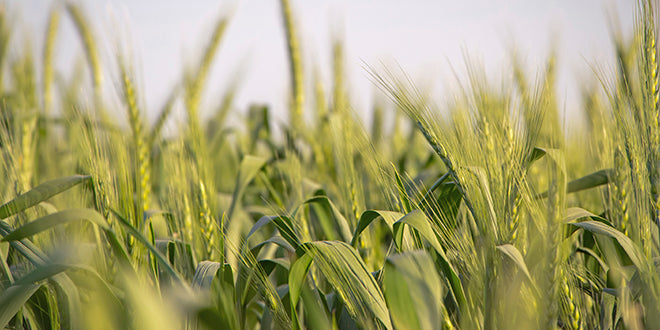There is so much confusion today regarding grains! Many realize that today, most grains contain gluten, and are acidic. Then there is the incredible difference between whole grains and refined grains. And besides all that there is the question as to what happens when we cook grains – are nutrients and enzymes lost?
These and many other questions regarding grains will be answered over the next few weeks in this Hallelujah Health Tip. But let’s begin by asking the question in the title of this article – “Did Adam and Eve Eat Grains?"
Did Adam & Eve Eat Grains?
This may come as a shock to you, but it is doubtful Adam and Eve ever consumed grains of any kind while they were in the Garden, and for sure they never consumed “refined” grains or “cooked” grains. How can we come to this conclusion?
First, grains are, as Webster’s Dictionary defines them: “a small, hard seed, esp. the seed of a food plant such as wheat, rye, oats, rice, or millet.” And though these grains (seeds) were present in the Garden, it would be extremely difficult to harvest enough to make a meal. Imagine picking enough seeds off of a plant to make a meal.
Second, there was no fire in the Garden with which to cook the grains! If fire was not available in the garden, how could they have prepared those grains for eating?
Third – Regarding the cooking of grains, the very first time the word “fire” is found in the Bible occurs in Genesis 19:24, when “The Lord rained upon Sodom and upon Gomorrah brimstone and FIRE. . . . .”
One could also assume that Abel's offering in Genesis 4:4 required fire, though the word "fire" is not mentioned. Still, even this event was after expulsion from the Garden.
We also know that fire was available to Noah immediately after the flood, because in Genesis 8:20 he offered a “burnt offering” to the Lord, but even this use of fire occurred some 1,700 years after Adam and Eve had been ejected from the Garden.
In the Garden of Eden, some raw grains (seeds) could have been soaked for several days in order to soften their hard shell, sprout them, and make them edible, but that is extremely unlikely.
Yes, they could have cracked a coconut in half and used the shell as a container to soak the seeds, but with so many easily obtainable foods available in the garden that could just be picked and immediately eaten, it is doubtful they went to all the trouble of picking enough seeds to make a meal, and then soaking them several days to make them edible.
So with that as a little Biblical background as to whether or not Adam and Eve ate grains, let’s talk about the use of grains today, as well as the use of grains on the Hallelujah Diet.
Whole Grains On The Hallelujah Diet
Before we talk about refined grains, I want you to understand that some whole grains, in limited quantities, are indeed a part of the Hallelujah Diet. Whole grains are complex carbohydrates, which help us reach our caloric needs and help to ensure we receive sufficient protein from our diet. However, even whole grains convert to sugar fairly rapidly, and thus it is not desirable to consume large amounts of even whole grains too frequently – probably not more than once a week. Also, it is important to realize that wheat, even in its whole and unrefined form (as well as in its refined form), is today one of the most acidic and possibly least desirable of all grains. The best way to consume wheat is in the raw and sprouted form. Sadly, relatively few whole grains are available on the market these days, and thus very few are consumed. Today, virtually all the breads, cereals, pastas, rice, corn, grits, etc. are processed and refined. Americans, as well as much of the rest of the world today, have a love affair with soft, white pastries; breads made with bleached white flour; and cereals that have first been divested of most of its fiber — and then dipped in sugar, making most cereals a double whammy!Whole Grains, When Cooked, Are A Dead Food
All grains have their beginning in the living seed of a living plant! This seed, before processing or cooking, contains life in the form of enzymes. In fact, each seed contains within it the very source of LIFE for a brand new plant. But by the time it reaches the cooked or refined stage, all enzymatic activity (life), has been destroyed, and it has been reduced from a seed containing life to a very dead food, devoid of all enzymatic activity (or life form). Heating any living food above 122 degrees kills the enzymes, its life force. Our physical bodies are living organisms, comprised of living cells that were designed by God to be nourished with living foods, foods high in enzymatic activity. This most basic knowledge is also the key to understanding what is (and what is not) proper fuel or nourishment for the human body! Consuming food in its living and raw form is also key to the proper nourishment of all species of animal life in the wild. Every animal in the wild, whether herbivore or carnivore, by instinct, ever since creation to this present day, consumes all of its food in its natural, raw, and living form! For proof, look at how all animals in nature get and eat their foods. Only man, thinking he is so wise, and so much smarter than the dumb animals in the wild, could display such arrogance and such ignorance as to destroy the life (enzymes) found within living plant foods before placing them into his mouth. The Bible tells us “The wisdom of this world is foolishness with God.” Friend, the Genesis 1:29 diet, which God the Creator gave that first couple, Adam and Eve, along with all the animals He created, was comprised of 100% raw, living (enzyme rich) foods!Life begets life! Death cannot produce life, death can only beget more death!Dead food cannot properly nourish a LIVING organism, whether it is the body of a human or that of an animal. When a predominantly dead food diet is consumed by either human or animal, physical breakdown is the penalty for that violation. Many pet owners wonder why their dog or cat develops many of the same physical problems humans experience. Dogs and cats were created by God to be nourished with raw foods, enzymatic live foods, just like humans. Most pet foods available today, that come in boxes or cans, have had the enzymes, their life force, destroyed in the heat processing of those foods. These dead foods cause physical breakdown, necessitating trips to the vet in an effort to undo the problems caused by the dead food diet the animal has been eating.
Try This "Living Food - Dead Food" Experiment...
Go to the health food store and buy a pound of raw, organic, whole wheat berries (seeds). At home, take half of the wheat berries (seeds) and simmer them in boiling water for 10 minutes. Then drain, cool, and place the cooked seed in a small mason jar with an old piece of clean nylon stocking over the opening, fastened in place with a rubber band, and place the jar on its side. In a second mason jar, place the remaining raw, organic, whole wheat berries, with an old piece of clean nylon stocking over the opening, fastened in place with a rubber band as above, and soak the seed overnight in room temperature water. In the morning, drain completely, rinse the seed, and place the jar on its side. Then each morning and evening, rinse the seeds in both jars with room temperature water, drain completely, and place on their sides. After a few days you will find that the jar containing the uncooked grain will start to sprout roots while the jar containing the cooked grain will not only not sprout roots, but start to rot, mold, and smell. Right there before your very eyes, you will visually see the difference between a dead food and a living food. Now, think about this: If even a whole organic grain becomes a dead food through the simple act of placing it in boiling water for a few minutes, think about how much living (raw) food you are placing into your body on a daily basis to nourish your living cells. The average diet of the average person today, is predominantly (if not almost entirely) comprised of dead foods — and we wonder why we suffer from so many physical breakdowns! The Bible tells us that what we sow we will also reap (both in physical and spiritual terms)!“Be not deceived: God is not mocked: for whatsoever a man soweth, that shall he also reap.” ~ Galatians 6:7
Why Does The Hallelujah Diet Include Cooked Grains?
The Hallelujah Diet calls for 15% of the foods consumed each day to be in the cooked form, including some grains. For instance, we recommend baked sweet potatoes, steamed vegetables, cooked soups, cooked whole grains and even some whole grain pastas, baked squash, and cooked beans. This may sound like a contradiction after all we have said above regarding cooked foods, but there is a reason for these cooked foods being included in the Hallelujah Diet — based on almost 40 years of my personal experience and research, as well as the experiences of tens-of-thousands of others who have written to me and told of their personal experiences. Following are a few of the reasons why cooked foods are included: 1. The average person is addicted to cooked food, and when that person tries to eat an all-raw diet, they are inclined to cheat. This cheating often gets out of control, and they get so discouraged they throw in the towel, so to speak, and go back to their old, nearly 100% cooked food diet. When given the opportunity to include 15% cooked foods on the Hallelujah Diet, it helps satisfy the longing for cooked foods. 2. Many find it difficult to chew enough raw plant sourced foods to obtain sufficient calories, especially if they have dentures. If sufficient calories are not consumed, the body may not receive sufficient protein. (More on this subject in next week’s Health Tip.) 3. We also need sufficient calories, especially in the form of carbohydrates, in order to have adequate energy. Some people, especially those who consume an excess of fruit (which we limit on the Hallelujah Diet because it contains so much sugar), find they have very low energy. 4. Some need more calories in order to keep from becoming too thin. Everyone strives to be trim, but some people become too thin if they do not consume some concentrated carbohydrates in the cooked form. 5. Adding 15% cooked foods to the diet provides all of the above benefits, along with making the diet much more doable, while obtaining at least as good (if not better) results than trying to maintain a 100% raw, plant-sourced diet. Interestingly, some nutrients are even more readily available to the body from foods when cooked – lycopene, found in tomatoes, being one of them. In fact, as part of the Hallelujah Diet, Rhonda and I consume a moderate amount of cooked grains most every week. When I first started advocating that 15% of a vegan diet should be consumed in cooked form, I was seriously criticized by most of the raw vegan community. It is interesting to note that today, some 20 years since I started encouraging some cooked food be added to the all raw vegan diet, most vegans have adopted what I have been advocating all these years. Why? Because adding some cooked food to the raw diet gets better results! I adopted a 100% raw (living), plant-based diet 38 years ago, along with large quantities of 100% raw (enzymatically alive), freshly extracted vegetable juices, after being told he had colon cancer in 1976. After one year on a 100% raw diet, with my cancer gone, I added 15% cooked plant sourced foods back into my diet, and my diet has been at least 85% raw, plant-sourced foods, along with some cooked plant sourced foods, along with an abundance of vegetable juices every day since. As I approach my 80th birthday, I still have most the physical abilities I had as a teen, and a mind superior to when I was a teen. This Hallelujah Diet has not only worked for me, but for Rhonda also, and for millions of others around the world. I highly recommend it! To be continued . . . . If you are not already on The Hallelujah Diet, click here to give it a try! Multitudes have made this diet change that we teach here at Hallelujah Acres, and experienced normalization of weight, as well as the elimination of almost all their physical problems.
Next week, the good Lord willing and if the creeks don’t rise too high we will return with another exciting issue of the Hallelujah Acres Health Tip. Trust you will join us and that you will share these Health Tips with friends and loved ones.





